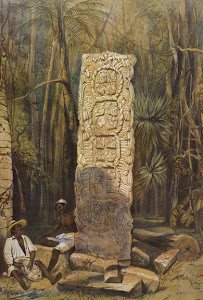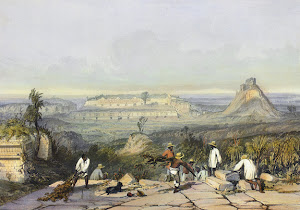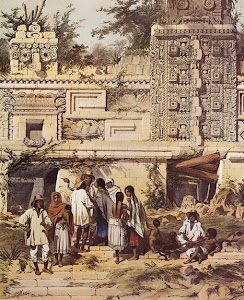__Una servidora se lo ha pasado en compañía de su Tesis (el tiempo apremia).
_ Había hecho una pausa para informaros de que Simon Martin daría una conferencia en The PreColumbian Society at the University of Pennsylvania Museum, como se informa en el foro de Aztlan; pero he entrado en la pagina de la Sociedad y parece que ha sido un error y no habrá tal ponencia. Así que, en su lugar, colgaré una de las ilustraciones de Catherwood y el texto explicativo correspondiente, pertenecientes a la exposición Drawing from the Past: Maya Antiquity through the Eyes of Frederick Catherwood, retomando así una costumbre descuidad hace tiempo. Que termineis bien el domingo.
__
Lámina 19: Entrada de Labnah
_
 _
___"La técnica de Catherwood utilizada en esta lámina deja ver algunos de los signos característicos del movimiento artístico conocido como Romanticismo. En la imagen, los indígenas dirigen la atención del espectador hacia el grandioso espectáculo que constituyen estas ruinas Maya. Nótese que los sujetos humanos tienen su atención enfocada en el edificio del fondo. Dos hombres que trabajan en la parte alta del edificio también tienen la mirada hacia atrás. La postura holgazana de los trabajadores Maya de la época, refuerza aún más su papel de accesorios de las ruinas antiguas.
__Pero las ruinas en sí no deben ser ignoradas. El acercamiento revela imágenes como la cara tallada del extremo izquierdo, y el patrón en zigzag a lo largo de la fachada frontal. Sin embargo, la característica arquitectónica más notable aquí es la bóveda de voladizo, que también aparece en las láminas 7 y 17. Esta especie de corredor arqueado se caracteriza por una cúspide plana, a diferencia de los arcos redondeados de la antigua Roma. Su ubicación justo en el centro de la litografía logra atraer la mirada hacia su interior.
__En Incidentes de un Viaje, John Stephens, el compañero de Catherwood, habla acerca de Labnah, sitio desconocido aun para los habitantes nativos del área. La estructura aquí representada, corrobora que Labnah es un lugar “de reliquias, que aunque deterioradas, sigue manifestando la gloria de un pueblo misterioso.” El grabado refuerza el carácter enigmático de Labnah, ciudad construida por un pueblo igualmente intrigante".
_
__Pero las ruinas en sí no deben ser ignoradas. El acercamiento revela imágenes como la cara tallada del extremo izquierdo, y el patrón en zigzag a lo largo de la fachada frontal. Sin embargo, la característica arquitectónica más notable aquí es la bóveda de voladizo, que también aparece en las láminas 7 y 17. Esta especie de corredor arqueado se caracteriza por una cúspide plana, a diferencia de los arcos redondeados de la antigua Roma. Su ubicación justo en el centro de la litografía logra atraer la mirada hacia su interior.
__En Incidentes de un Viaje, John Stephens, el compañero de Catherwood, habla acerca de Labnah, sitio desconocido aun para los habitantes nativos del área. La estructura aquí representada, corrobora que Labnah es un lugar “de reliquias, que aunque deterioradas, sigue manifestando la gloria de un pueblo misterioso.” El grabado refuerza el carácter enigmático de Labnah, ciudad construida por un pueblo igualmente intrigante".
_
_
Plate 19: Gateway at Labnah (on stone, by J. C. Bourne)
Plate 19: Gateway at Labnah (on stone, by J. C. Bourne)
_
__"In this image, indigenous people draw the viewer’s attention to the spectacle of the Maya ruins. Notice that the human subjects have focused their attention on the edifice at the background. Two men seen working atop the building also lead the eye backwards. The nearly-lounging posture of the contemporary Maya workers reinforces their role as accessories to the spectacle of the ancient ruins.
__Yet the ruins themselves are not to be ignored. Close inspection reveals images such as the carved face at the far left and the zigzagging pattern along the front of the façade. However the most noteworthy architectural feature here is the corbel vault, also present in Plates 7 and 17. This type of archway is characterized by a flat peak, differing from the rounded arches of Roman antiquity. Its location at the center of the lithograph draws the eye inward.
__In Incidents of Travel, Catherwood’s companion John Stephens speaks of Labnah, a place unknown even to many of the native people of the area. This structure emphasizes Labnah as a place of “…decaying but still proud memorials of a mysterious people.” The print reinforces the idea of Labnah as an enigmatic place built by people of equal intrigue".
___"In this image, indigenous people draw the viewer’s attention to the spectacle of the Maya ruins. Notice that the human subjects have focused their attention on the edifice at the background. Two men seen working atop the building also lead the eye backwards. The nearly-lounging posture of the contemporary Maya workers reinforces their role as accessories to the spectacle of the ancient ruins.
__Yet the ruins themselves are not to be ignored. Close inspection reveals images such as the carved face at the far left and the zigzagging pattern along the front of the façade. However the most noteworthy architectural feature here is the corbel vault, also present in Plates 7 and 17. This type of archway is characterized by a flat peak, differing from the rounded arches of Roman antiquity. Its location at the center of the lithograph draws the eye inward.
__In Incidents of Travel, Catherwood’s companion John Stephens speaks of Labnah, a place unknown even to many of the native people of the area. This structure emphasizes Labnah as a place of “…decaying but still proud memorials of a mysterious people.” The print reinforces the idea of Labnah as an enigmatic place built by people of equal intrigue".
Jessica DEBRUIN (Exposición Online: Drawing from the Past)




























3 comentarios:
Hola Rocío... te saludo desde Guatemala y te cuento que soy estudiante de noveno semestre de arqueología. Me gusta mucho el trabajo de Catherwood (como a muchos de nosotros, por supuesto) y me gustaría saber donde hallaste las láminas.
Un saludo colega,
Mauricio Díaz.
mr.kacike@gmail.com
Hola Mauricio. Las imágenes y textos los saqué de la Exposición Online Drawing from the Past, en la siguiente dirección: http://www.smith.edu/libraries/libs/rarebook/exhibitions/catherwood/index.htm
Que bueno que me lo recuerdas, para seguir colgando imágenes y textos hasta completar la colección expuesta. Saludos y puede que hasta el Simposio de Investigaciones Arqueológicas de este año.
Vale, gracias por el link. Se te agradece que colgués las imágenes, siempre es interesante verlas y leer su descripción.
Con suerte y nos tomamos un café en el Simposio.
Publicar un comentario